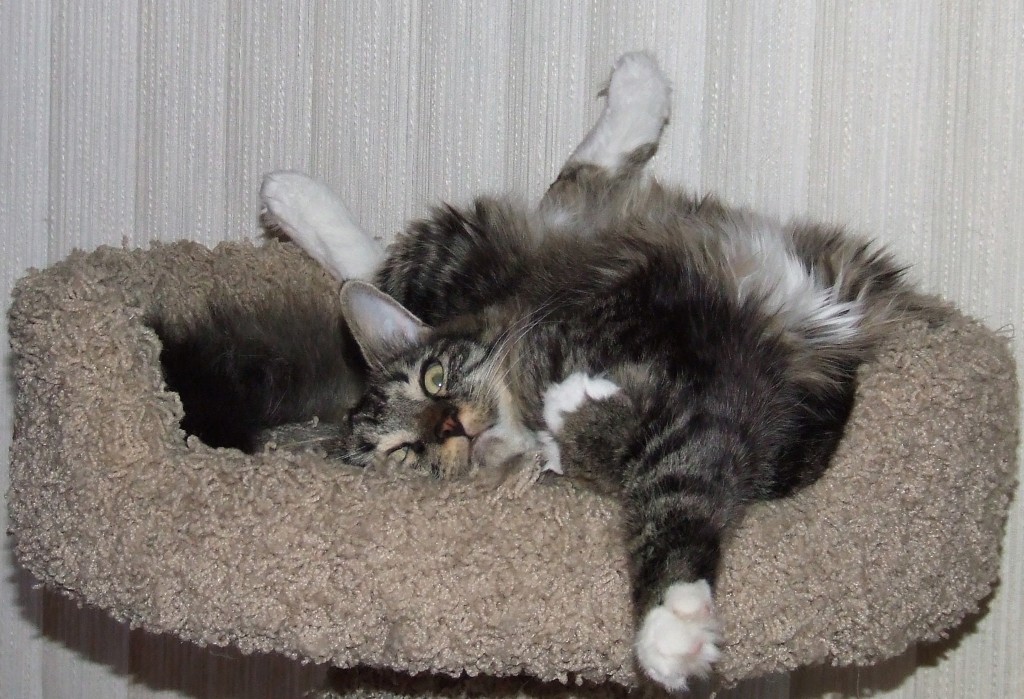Written by Tracy Dion, August 2012, and published in ‘Catnip Chronicles,’ October 2012.
 When cat owners start researching feline nutrition, the amount of data they have to weed through can be overwhelming. And when they finally reach the conclusion that a wholesome, species-appropriate raw diet is what they should be feeding, they’re only half way home.
When cat owners start researching feline nutrition, the amount of data they have to weed through can be overwhelming. And when they finally reach the conclusion that a wholesome, species-appropriate raw diet is what they should be feeding, they’re only half way home.
There are several methods that can be used to raw feed cats, and there are an infinite number of opinions about which one is “right”. In truth, any balanced raw diet will provide your cat with enormous nutritional benefits when compared to standard commercial diets. Which one you choose to feed should depend upon your particular resources, lifestyle and personal preferences, and not so much on someone else’s opinion.
Overview
Raw diets can be either bought pre-mixed, or made at home, and each method has its pros and cons. Commercially packaged raw foods are convenient and often no more expensive than standard commercial diets, but they are still commercially manufactured and run the same quality control risks as all processed products. They are also, at this time, available in ground mixes only. Home-made diets can be prepared in three forms – ground, prey model raw (PMR) and whole prey – and require a bit more preparation and serving time. Home-made ground and PMR diets, however, are typically the least expensive feeding options, raw or otherwise, and home-preparing your cat’s food allows you complete control over the ingredient mix and quality.
Whichever diet you chose, variety should be a key component. If you go with commercial, feeding several flavors from multiple manufactures will help prevent feline fixation on any one product – a problem if they change or stop producing it – and protect your cat from potential quality control issues by diluting the impact. In addition, since cats can develop hypersensitivity when continually exposed to the same proteins or ingredients for extended periods, rotating through several products will help prevent food intolerance issues.
If you’re home-preparing your cat’s diet, variety will be necessary to ensure she receives a complete nutritional profile. Studies have shown that lions and other big cats require 5 to 7 different protein sources to fulfill their nutritional requirements, but it is generally accepted that 3 to 5 is sufficient for their domesticated cousins. Of course, providing more than five proteins can’t do anything but improve the nutritional profile you’re feeding. And don’t forget insects! You can feed a handful of crickets every week (just drop them in the tub with the drain cover on) and add trace amounts of nutrients to your cat’s diet while simultaneously allowing your miniature tiger to exercise some of her hunting instincts.
One caveat to sourcing a maximum variety of foods; keep fishy products out of the rotation, as they are not a healthy addition in anything but small amounts. Among other problems, they can contribute to urinary tract issues due to their high magnesium content, and can cause both thiamin and Vitamin E deficiencies.
A single sardine once or twice a week, however, is a great source of Omega 3’s and will avoid the problems associated with large amounts of other fish types.
Generally, you can feed your cat anywhere between 2% to 4% of her weight in ounces. More laid-back cats that don’t get a lot of exercise and those with slow metabolisms can be fed at the lower end, energetic cats and those with fast metabolisms can be fed at the higher.
There are a large number of commercial raw products available today and more are coming to market all the time. In addition to an awareness of each manufacturer’s quality control practices and history, you should carefully review the ingredients list of these products. Some contain fruits and vegetables which, though not needed in a cat’s diet, shouldn’t cause any digestive issues if present at or less than 5%.
Pay attention to the meat/bone/organ percentages, as well. Some products contain more than 10% bone and amounts that high can cause constipation. These foods are fine to feed if included as part of a rotation of products from multiple manufacturers, but you should keep a careful eye on the litter box.
Other products contain no bone at all, and these can be included in a rotation of foods but very sparingly. Too little bone in a cat’s diet will lead to loose stools and, over the long term, much more serious issues. These foods can’t be fed as the sole diet without some type of bone supplement.
Speaking of which, supplements, too, can cause issues. Generally speaking, the more additives a raw food has, the more likely it is that something in the food may cause a digestive upset. Try to feed products with minimal or no supplements.
Commercial raw products are currently only available in ground form. This is a benefit for many, as it is closer to the canned foods most commercial-fed cats have been eating and may be more acceptable to those cats than prey model or whole prey raw diets. Unfortunately, ground diets do not provide the dental and psychological benefits of PMR and whole prey and many cats will eventually stop accepting ground in favor of something they can sink their teeth into.
An extensive and detailed analysis of the most widely available commercial raw cat foods is available here.
Home-prepared Raw Food
Ground and prey model home-prepared diets are based on a general guideline used by raw dog feeders for decades and slightly modified for the cats smaller prey: the 83 / 7 / 5 / 5 rule; that’s roughly 83% meat, fat, skin, sinew, connective tissue and heart, 7% edible bone, 5% liver, and 5% other secreting organ (kidney, thymus, pancreas, etc.).
Two preset calculators that require just your cat’s weight, your desired weight percentage (usually 3%), and the number of days over which you wish to balance the diet (usually 7) can be found here: 1997-2003 Excel and 2010 Excel.
Whole prey, of course, is as close to natural as your cat can get without catching dinner on its own.
A ground home-prepared raw diet involves grinding all the meats, organs, and bones together. It is convenient in its simplicity and offers the same cost savings of PMR, but like commercial diets, it does not provide a chewing challenge to the cat and, due to the nutrient breakdown inherent in the process, typically requires supplementation.

There are several tried and true ground diet recipes that can be found online, although it may take some research to find them. The Feline Nutrition Education Society’s website and Dr. Lisa Pierson’s website are good places to start.
In a prey model raw diet (also called a “frankenprey” diet), a variety of animal parts are fed in measured amounts so that over a certain period of time, usually a week, the cat will eat approximately the same sum of parts as it would have were it eating whole animals. Meals are often all meat or a mix of meat with bone or organ and are fed in large chunks that the cat must actively gnaw on to reduce to bite-size pieces that can be swallowed.
This active engagement in the eating process has several benefits for the cat, including the psychological satisfaction inherent in successfully meeting mental and physical challenges (eating becomes work!). One of its more important benefits, however, is improved dental health. Dental disease is at near-epidemic levels in the feline population and has far-reaching health consequences for the cat. A diet that includes tearing, ripping and scissoring through meat, tendons and bones provides the necessary stimulation to keep your cat’s mouth clean and healthy.
In addition, the very act of scissoring through chunks of fresh raw protein sets off a chain reaction that releases a more efficient combination of enzymes in the cat’s digestive system (starting with the saliva) and this, combined with the extended time required to finish a meal, promotes an easier, more efficient digestive process.
Most of the meats, bones and organs for home-made ground and PMR diets can be bought in local grocery stores, making these diets fairly easy to source. Additional products, especially organs, can be found in ethnic stores or ordered online. Organic products are just as much healthier for your cat as they are you, but are not critical to a balanced raw diet.
Whole prey diets are the least common of the three home-prepared options. Although feeding whole animals such as mice, rats, young chicks, and quail is, obviously, the most natural method, it is the least acceptable to both cat owners, who sometimes find it emotionally difficult to handle small dead animals, and cats, who often have trouble even recognizing the prey as food. If both owner and cat can get past these difficulties, however, whole prey is the easiest, most nutritious and beneficial method of raw feeding. Animals for these diets can be purchased from local stores that cater to reptile owners or from a growing number of online vendors (see Sourcing Products for Homemade Cat Food for a list of vendors).
Prey model raw and whole prey diets generally require no supplementation, but, again, variety is key. There are no recipes as such for these diets, but you can see an example of this diet here.
One thing to keep in mind with a PMR diet is the need for a schedule. Maintaining the 83/7/10 balance is critical, and if your daily schedule is anything like mine, writing down a weekly plan and taping it to the refrigerator will go a long way to ensuring you don’t forget any important components.
You’re almost guaranteed to encounter pushback when you decide to switch your kitty to a raw diet – especially from your allopathic veterinarian – and you’re going to hear and read a wide range of sometimes conflicting opinions. Try not to stress it! A balanced species-appropriate diet is so extraordinarily nutritious it’s really hard to go wrong, and one of the many cool aspects of raw feeding is that this diet – unlike canned or kibble – can be completely customized for your individual needs. Between commercial and home-prepared, raw feeders have an extensive array of selections to choose from, so no matter what your time, financial or logistical resources, there’s a raw food option that will fit your lifestyle.
———-
For more info on home-prepared raw diets:
Getting-started tips for prey model raw feeding.
Troubleshooting the Transition: A rundown of the most commonly experienced transition issues.
A Complete Prey Model Raw / Whole Prey Feeding Guide
If you enjoyed this article or found it informative, please “Like” it, “Tweet” it, or share it using any of the buttons below. And don’t forget to check out our FB page, join the discussions in our awesome FB group and follow us on Twitter!
Created 08/31/12; Updated 09/18/17



